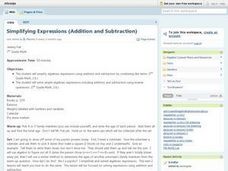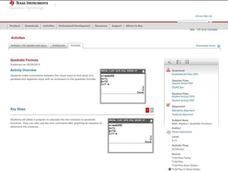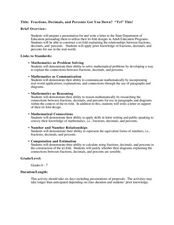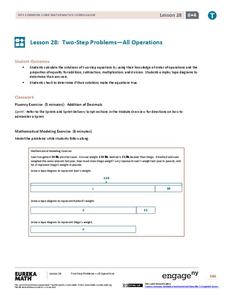Curated OER
Inequalities and The Order of Operations
Middle and high schoolers investigate how to solve inequalities. The lesson has a good guide for taking pupils through a direct instruction of the concept. You can use counting tiles in order to help kinesthetic learners.
Curated OER
Quadratic Equations
In this algebra worksheet uses factoring to solve and graph quadratic equations. The three page worksheet contains explanation of topic, worked examples and five practice problems. Answers are not provided.
Curated OER
Count on Me
Fourth graders use inductive reasoning to find algebraic patterns in geometric figures. They use technology (i.e., calculators, computers) and manipulatives to discover number patterns involving geometric concepts. They solve concrete...
Curated OER
Simplifying Expressions (Addition and Subtraction)
Seventh graders simplify algebraic expressions using addition and subtraction to combine like items and solve for the variable. They work with inverse operations to solve equations with guided practice. Everyone completes various...
Curated OER
Unit 9 Review
Middle and high schoolers solve and complete 15 various types of problems that include evaluating expressions and graphing. First, they use the substitution method to solve pairs of equations for a variable. Then, students write out a...
Curated OER
Zero Product Property and Quadratics
In this quadratic learning exercise, algebra learners use the zero product property to solve basic quadratic equations. They identify where the parabola crosses the x-axis. Explanations and examples are provided. Answers are located on...
Curated OER
Practice Makes Perfect
Middle schoolers solve four problems in which the variable N is isolated and its value determined. There are multi-step equations. The problems are closely spaced and the way they are typed may confuse students.
Curated OER
Quiz: Solving Equations
In this solving equations worksheet, students solve one- and two-step equations containing one variable, as well as positive and negative whole numbers. Students examine equations containing multiplication, addition, and subtraction....
Curated OER
Quadratic Formula
This worksheet is part of the TI-Nspire lesson on the quadratic formula. Pupils determine the solutions of a quadratic function by looking at a graph and the discriminant. They use the quadratic formula to solve quadratic functions on...
Curated OER
Fractions, Decimals, and Percents Got You Down? "Tri" This!
Have your class design their own mathematical study aids. Learners collaborate in groups on the design of tri-fold presentation describing the relationships between mathematical computations. Then, they write a business letter to the...
Kenan Fellows
Math Made Simple as 1-2-3: Simplified Educational Approach to Algebra
Writing an equation of a line is as easy as m and b. A lesson presentation gives individuals different strategies for writing equations of lines. Some items provide a slope and a point while others provide two points. Whatever the given,...
Curated OER
Another Way of Factoring
Focusing on this algebra lesson, learners relate quadratic equations in factored form to their solutions and their graph from a number of different aspects. In some problems, one starts with the original equation and finds the...
Utah Education Network (UEN)
Expressions and Equations Part 1
Express your love of equations! Pupils first learn to write and simplify numerical and algebraic expressions. Then, create and solve two-step equations. The progression is a great way to introduce the concept slowly.
Flipped Math
Greatest Common Factor
Break it down to solve it. Learners watch a video on how to factor out the greatest common factor for algebraic expressions. They see how to use factoring and the zero product property to solve polynomial equation and practice their...
Flipped Math
Intro to Proofs
Prove the best way to keep up in Geometry. Scholars first review algebraic properties from Algebra. Learners then use the properties to create two-column proofs to solve linear equations before completing algebraic proofs by providing...
CCSS Math Activities
Smarter Balanced Sample Items: 6th Grade Math – Target G
Making money and saving money turn into high interest topics for sixth graders. Grade 6 Claim 1 Item Slide Shows use these topics in a presentation with math practice problems. The questions require applying knowledge of algebraic...
CCSS Math Activities
Smarter Balanced Sample Items: 7th Grade Math – Claim 2
To solve or not to solve that is the problem. A slide presentation of 17 items show different ways that Smarter Balanced assesses Claim 2, problem solving. The items span from sixth and seventh grade concepts to highlight the...
EngageNY
Linear Equations in x
What does it mean to solve an equation? The resource revisits the concept of making a linear equation true. Classmates use algebraic methods to transform sides of equations to expressions with fewer terms. They use substitution to...
EngageNY
Two-Step Problems—All Operations
Step 1: Use the resource. Step 2: Watch your class become experts in solving two-step problems. Scholars learn to solve two-step word problems in context. They use tape diagrams and algebraic techniques to break the problem into two,...
EngageNY
Graphing Solutions to Inequalities
Activate the strengths of your visual learners using an informative instructional activity. In the 15th installment of the series of 28, pupils graph their solutions on number lines to create a visual representation of solutions....
EngageNY
Multi-Step Ratio Problems
Use ratios to solve problems that are not proportions. The instructional activity has pupils solve multi-step ratio problems that involve fractional increases and decreases. The problems involve mark-ups, discounts, commissions, and...
EngageNY
Getting a Handle on New Transformations 2
Use 2x2 matrices to move along a line. The second day of a two-day instructional activity is the 28th installment in a 32-part unit. Pupils work together to create and solve systems of equations that will map a transformation...
Flipped Math
Factor Trinomials
Is it possible to factor out more? Scholars view a video presentation on factoring second degree trinomials. They learn about the magic X method to keep track of the constant factors. To finish, scholars use the learned method while...
EngageNY
Inequalities
The 13th activity in the 28-part module asks scholars to write linear inequalities from a problem situation. Individuals then solve and interpret their results in the context of the problem.























